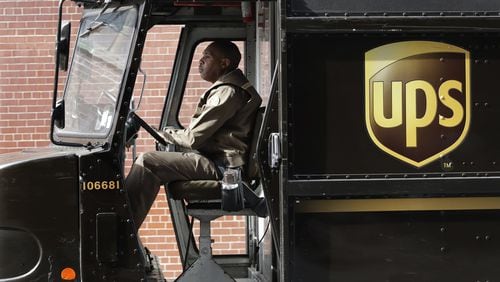UPS, grappling with the effect of rising home delivery volumes, plans to start levying peak surcharges for packages shipped to homes during the busiest periods of the holiday shipping season.
Sandy Springs-based UPS’s surcharges will add 97 cents per packages shipped via second-day air residential service Dec. 17-23.
For next day air residential service, there will be an 81 cent surcharge per package Dec. 17-23.
And packages sent via ground to residences will cost an extra 27 cents if shipped Nov. 19-Dec. 2, or Dec. 17-23.
UPS said the peak surcharges are aimed at covering extra costs it incurs during volume surges, including the cost of adding air and truck cargo capacity, temporary facilities and staff.
"UPS flexes its delivery network to process near double our already massive regular daily volume, and that creates exceptional demands," UPS chief commercial officer Alan Gershenhorn said in a written statement.
The shipping giant is also adding peak surcharges for particularly large, heavy or unusually shaped packages that "create even greater operational complexity during high-demand periods," and is encouraging customers shipping such items to use UPS Freight instead of its package shipping service.
The continued growth in popularity of online shopping puts a strain on UPS’s infrastructure during the holidays, requiring it to significantly scale up its operations for the peak period — and incorrect forecasts can mean delivery delays or financial challenges, or both.
UPS in 2015 said it would begin levying peak surcharges for residential packages, after hiring more temporary employees than it had forecast to handle the 2014 holiday rush.
The company has already been charging extra to retailers who exceed their forecasts for volume during the holiday period, which will continue, and has had peak season surcharges in areas such as international air freight. But this is the first time UPS has published peak surcharges for U.S. domestic residential package deliveries.
Still, its biggest customers, such as Amazon, typically negotiate rates that may differ from published rates.
The published peak surcharges are “not about incentivizing the customer to purchase at a certain time,” said spokesman Glenn Zaccara. “Our focus here is on recovering the cost that the company incurs when we flex our network.”
Last year, UPS hired more than 95,000 seasonal workers to prepare for the holiday shipping period, opened 15 new or expanded hub facilities, installed “mobile delivery villages” and added capacity at its facilities.
About the Author




/cloudfront-us-east-1.images.arcpublishing.com/ajc/P7DYBH6TO7FEKG4SUXQQKADRXE.jpg)


